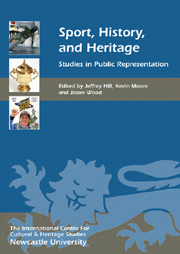Book contents
- Frontmatter
- Contents
- List of Illustrations
- Acknowledgments
- Sport, History and Heritage: An Investigation into the Public Representation of Sport – Editors' General Introduction
- HISTORY, HERITAGE AND SPORT
- MUSEUMS AND THE REPRESENTATION OF SPORT
- 7 Sport in Museums and Museums of Sport: An Overview
- 8 The Everton Collection: Unlocking the Value of a National Football Archive
- 9 Culture, Commerce, Capitalism and Commemoration: Dmitri Piterman and the Alavés Football Museum
- 10 Replacing the Divots: Guarding Britain's Golfing Heritage
- 11 Upping Our Game: The New Wimbledon Lawn Tennis Museum
- SURVIVALS AND LEGACIES: SPORT, HERITAGE AND IDENTITY
- Afterword: History and Heritage in Sport
- List of Contributors
- Index
- HERITAGE MATTERS
10 - Replacing the Divots: Guarding Britain's Golfing Heritage
from MUSEUMS AND THE REPRESENTATION OF SPORT
Published online by Cambridge University Press: 05 April 2013
- Frontmatter
- Contents
- List of Illustrations
- Acknowledgments
- Sport, History and Heritage: An Investigation into the Public Representation of Sport – Editors' General Introduction
- HISTORY, HERITAGE AND SPORT
- MUSEUMS AND THE REPRESENTATION OF SPORT
- 7 Sport in Museums and Museums of Sport: An Overview
- 8 The Everton Collection: Unlocking the Value of a National Football Archive
- 9 Culture, Commerce, Capitalism and Commemoration: Dmitri Piterman and the Alavés Football Museum
- 10 Replacing the Divots: Guarding Britain's Golfing Heritage
- 11 Upping Our Game: The New Wimbledon Lawn Tennis Museum
- SURVIVALS AND LEGACIES: SPORT, HERITAGE AND IDENTITY
- Afterword: History and Heritage in Sport
- List of Contributors
- Index
- HERITAGE MATTERS
Summary
MATERIAL CULTURE, COLLECTIONS AND MUSEUMS
An essential aspect of golfing heritage is the legacy of material culture from the three centuries or so that the sport has been played in Britain. This is broad and covers most of the categories outlined in Hardy et al's (2009) recent typology. To the fore is playing equipment, with golfers changing over time from using fully wooden clubs to those with metal heads and (later) shafts and now the oxymoronic ‘metal wood’. The ball that they strike with these implements has developed from the 18th-century version, stuffed with feathers, through the 19th-century gutta-percha to the rubber core, invented in the early 20th century and the basis of the modern golf ball, each of them promising the user longer distance and greater control. Then we have prizes: the Claret Jug, denoting the connection of golf with alcohol, awarded to the winner of the Open Championship; the medals for club champions attached to the shaft of a club displayed in the clubhouse; and the plethora of engraved spoons given to those who overcame their handicap in the monthly club tournament. As for sportswear, club regulations have usually reinforced social convention in terms of golfing attire. Edwardian men played in suits and ties while women wore long skirts and bonnets. These are brought to us in photographs and film, the latter capturing bodily movement, an essence of sport.
- Type
- Chapter
- Information
- Sport, History, and HeritageStudies in Public Representation, pp. 147 - 160Publisher: Boydell & BrewerPrint publication year: 2012



